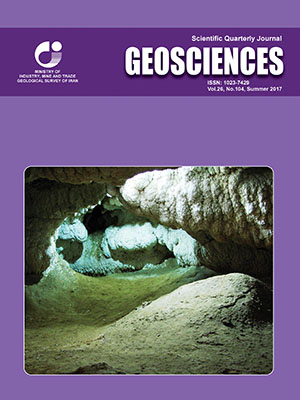References
Alavi, M., 2004-.Regional statigraphy of the Zagros fold-Thrust belt of Iran and its proforland evolution, American Journal of science,304. p.1-20.
Cetari, R. and Satorio, D., 1995- Rudist and Facies of the Priadriatic domain, Agip, 207p.
Corda, L. and Brandano, M., 2003- Aphotic zone carbonate production on a Miocene ramp, central Apennines, Italy. Sediment Geol 161(1-2), p. 55-70.
Defrance, I. L. M., 1816-27- Dictionaire des Set Nat., 21, Paris.
Douvill, H., 1904- Etudes Géologiques. Partie 4, Paléontologie, Mollusques fossiles. In: MORGAN, J.DE (ed), Mission scientifique en Perse, Paris 3, p. 191–380.
Douville H., 1910- Etudes sur les rudistes. Rudistes de Sicile, d’ Algerie, d’Egypte, du Liban et de la Perse: Memoires de la Societe Geologique deFrance 41, p. 1-83.
Farinacci, A. and KöylÜoglu, M., 1985- Anatalyna korayi n. sp. in the phletic lineage of the Nezzazazzzatidae(Foraminifera) , Rev. Micropal., 28(2) .103-108.
Flugel, E., 2010- Microfacies of Carbonate Rocks, Analysis, Interpretation and Application, Springer, Berlin – Heidelberg, New York, 976 p.
Francis, J. E. and Frakes, L. A., 1993- Rudist Formation of the Cretaceous : A Paleo Ecological, Sedimentological and Stratig Raphical review. In V.P.Wright(ed), Sedimentology review.No,1: Black Well Scientific Publication, Oxford, p. 17-30.
Geel, T., 2000- Recognition of stratigraphic sequences in carbonate platform and slope deposits: empirical models based on microfacies analysis of paleogene deposits in southeastern Spain: Paleogeography, Paleoclimatology, Paleoecology, 155, p. 211- 238.
Hallock, P., 1985- Why are larger foraminifera large? Paleobiology, pp. 195- 208.
Hottinger, L., 1997- Shallow benthic foraminifera assemblages as signals for depth of their deposition and their limitation, Bull. Soc. Geol. France, 168, p. 491-505.
James, G. A. and Wynd, J. G., 1965- Stratigraphic Nomenclature of Iranian Oil Consortium Agreement Area, American Association Petroleum Geologists Bull., 49(12), p. 2182–2245
Khazaei, A. R. Skelton, P. W. and Yazdi, M., 2010- Maastrichtian Rudist fauna from Tarbur formation (Zagros region-SW Iran), Preliminary. observations: Turkish Journal of Earth Sciences, v.19, p.703-719.
Lamarck, J. B., 1816- Suite des memoires sur les Fossiles des Enivrons de Paris. Annales de la Musée d’Histoire Naturelle de Paris, 5: 179-188.
Liewellyn,V. P., G., 1974- Geological map of Ilam- Kuh Dast, 1:250 000.
Meric, E and Gormuz, M., 2001- the genus Loftusia, micropaleontology, p.47-37.
Meric, E and Mojab, h., 1977- Word wide geography distribution of the species of the foraminifera genus Loftusia, istanbul university, fen fafultesi mecmvasi, B, 421 p.
Murray, J. W., 1991- Ecology and distribution of benthic foraminifera, In: Lee, J.J., Anderson, O.R. (Eds), Biology of Foraminifera. Academic Press, New York, p. 221–224.
NIOC (National Iranian Oil Company), 1976- Tang-E- Haft geological map, scale 1:100000.
NIOC (National Iranian Oil Company), 1977- Alshtar geological map, scale 1:100000.
Perin, C. and Bosellini, R., 2012- Paleobiogeography of scleractinian reef corals: Changing patterns during the Oligocene–Miocene climatic transition in the Mediterranean
, Earth-Science Reviews 111, (1–2), PP. 1–24
Pomar, L., 2001- Types of carbonate platforms: a genetic approach. Basin Res 13, p. 313–334.
Reiss, Z. and Hottinger, L., 1984- The Gulf of Aqaba: Ecological Micropaleontology. Ecological Studies, Springer-Verlag, Berlin, Vol. 50, p. 1–354.
Ross, D. I. and Skelton, P. W., 1993- Rudist Formation of the Cretaceous: A Paleo Ecological, Sedimentological and Stratig Raphical review. In V.P.Wright(ed), Sedimentology review.No, 1: Black Well Scientific Publication, Oxford, p. 73-91.
Scott, R. W., 1990- Models and stratigraphy of mid Cretaceous reef communities. Gulf of Mexico, Soc. Ecom. Paleon. Miner. Conc. Sedim. Paleont. 2, 102 pp.
Sherkaty, S. and Letouzey, J., 2004- Variation of structural style and basin evolution in the Central Zagros (Izeh zone and Dezful beltl Iran): Marine and petroleum geology, 21(5), p. 35-554.
Stocklin, J., 1968- Structural history and tectonics of Iran: a review, American Association Petroleum Geologist Bulletin, 52, p.1229–1258.
Tucker, M. E. and Wright, V. P., 1990- Carbonate sedimentology, Oxford Blackwell Scientific Publications, 425 pp.
Van Buchem, F., Gaumet, F., Vedrenne, V. and Vincent, B., 2004- Middle East sequence stratigraphy, Part 1: SW Iran, N. I. O. C. and I.F.P. report.
Warren, W. J., 2000- Dolomite: Occurrence, evolution and economically important association, Earth Sciences Review, 52, pp. 1-181.
Wynd, J. G., 1965- Biofacies of the Iranian oil Agreement area, N .I .O. C. report, No 1089

